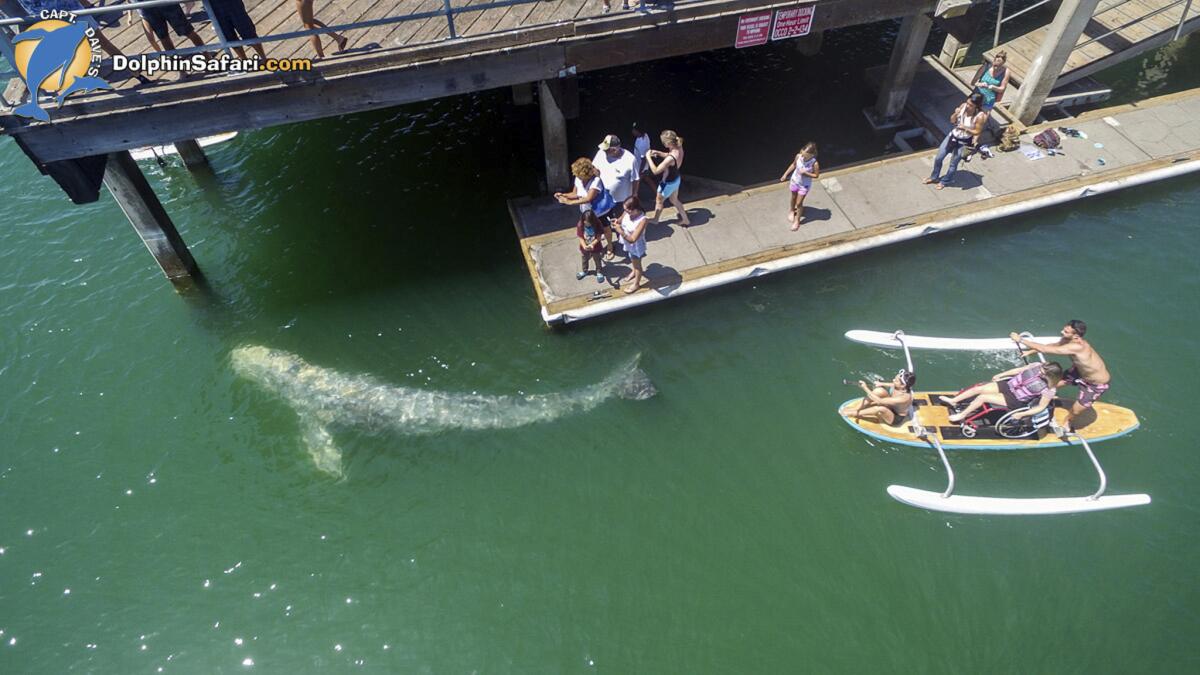Curious young whale, late for migration, continues north

- Share via
A 15- to 17-foot young gray whale spotted first in a Carlsbad lagoon and then in the harbor at Dana Point this week appears to be a straggler left behind in the annual northern migration, experts said Wednesday.
“It’s just like with people,” said Wayne Perryman, a biologist with the National Oceanic and Atmospheric Administration in San Diego. “The juvenile animals are likely to be in places they are not supposed to be, at times they’re not supposed to be there.”
Whales are seen occasionally along the North County coast, more frequently during the spring and fall migrations.
However, this was the first time anyone can remember one entering Carlsbad’s Agua Hedionda Lagoon. The whale spent about two hours Monday afternoon swimming back and forth inside the entrance beneath the Carlsbad Boulevard bridge, and went as far as a few hundred yards into the outer basin of the lagoon before leaving.
Agua Hedionda is the only North County lagoon dredged often enough to keep the mouth open and deep enough for a small whale to enter. Since 2015 the lagoon has provided water for the Carlsbad Desalination Plant, and since the 1950s it has cooled the Encina Power Station.
The young whale was either a calf born this year or a small yearling born last year, said Perryman, who works at NOAA’s Southwest Fisheries Science Center. A typical yearling is 25 to 28 feet long. Usually they begin their northern migration in April.
“Normally he would already be in the Arctic,” Perryman said. “Somehow this guy didn’t get the message.”
The whale seen Monday in Carlsbad and then Tuesday at Dana Point appeared thin but otherwise healthy, observers said.
A rescue team sent from SeaWorld San Diego to Carlsbad observed that “the animal did not seem in distress and had a normal respiration rate,” said SeaWorld spokesman David Koontz. The team left before the whale swam away.
At both its Southern California stops, small crowds greeted the whale. People lined the shore and a few tried to swim or paddle out to meet the creature, although officials asked them to stay away for safety’s sake.
It’s possible the whale may be accustomed to humans, said Regina Guazzo, a doctoral candidate studying gray whales at UCSD’s Scripps Institution of Oceanography.
“In the lagoons of Baja California you can actually go and pet the gray whales,” Guazzo said. “Organized tours go out in small boats.”
The boats are not allowed to approach too close to the whales in Mexico, she said. Instead, they go nearby and shut off their engines.
“For a few weeks (after the whales are born) the mothers are very protective, then they bring their calves near the boats and let them be petted and touched,” she said. “They do seem to seek out interaction, especially in the lagoons in Baja.”
A full grown Pacific gray whale can be 45 feet long and weight has much as 33 tons, according to the National Park Service. At birth, which usually occurs in January or February, they are about 15 feet long and weigh about one ton.
They can live 40 to 60 years, migrating annually from the winter feeding grounds in Baja California, Mexico, to their summer lay-over in the food-rich Arctic waters about 5,000 miles away.
Gray whales are the most understood of several whale species that migrate along the California, Guazzo said. That’s largely because the grays’ migration hugs the coast, where they are easier to see and study, while other species such as the fin, blue and humpback whales spend most of their time farther out in the ocean.
The fact that the whale calf is young and alone does not bode well for its easy survival, she said, but one good sign is that it’s headed north.
Some gray whales spend the summer feeding along the coast of Oregon or at Puget Sound in Washington, so if this one makes it that far he should find plenty of food, Guazzo and Perryman said.
The grays are baleen whales that have sheets of keratin, a substance like fingernails, instead of teeth. They eat small crustaceans such as shrimp or crab larvae that they stir up in the sand in shallow water.
Gray whales were nearly hunted to extinction in the 19th century. However, they have been protected internationally since 1946, and their population has recovered and continues to grow.
They are no longer endangered, and at last count there were more than 30,000 gray whales in the eastern North Pacific.
philip.diehl@sduniontribune.com
Twitter: @phildiehl
More to Read
Sign up for Essential California
The most important California stories and recommendations in your inbox every morning.
You may occasionally receive promotional content from the Los Angeles Times.














